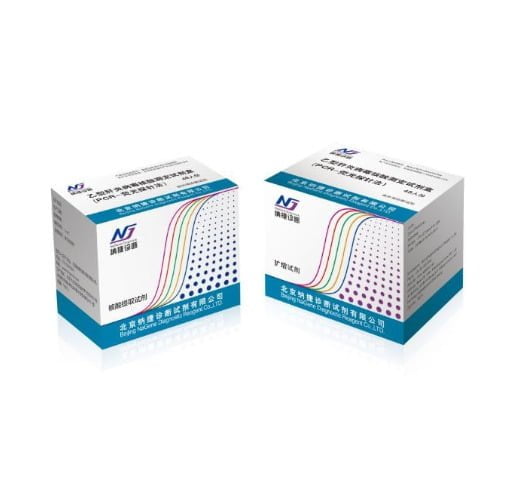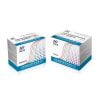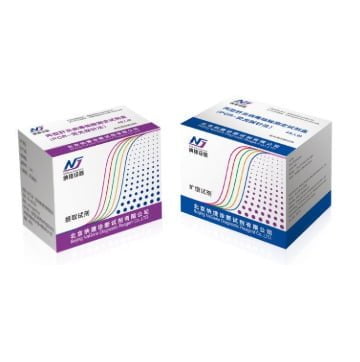【Product name】 Hepatitis B Virus Nucleic Acid Assay Kit (RAP-Fluorescent Probe Method)
【Package specification】48 Tests/ Kit
Intended use
- The kit is intended for the quantitative determination of hepatitis B virus (HBV) nucleic acid (ADN) in serum or plasma samples.
- It is utilized for patients requiring testing for HBV infection and those undergoing antiviral therapy for hepatitis B.
- Designed to monitor the response to antiviral treatment and assess treatment effectiveness by tracking HBV DNA levels in patient blood.
- Cependant, the test should not be solely relied upon as an indicator of a patient’s condition.
- It must be used alongside clinical manifestations and other laboratory tests to evaluate the patient’s overall condition.
- This kit is not suitable for HBV blood screening purposes.
Test Principle
- The kit employs conformational magnetic beads to both lyse and purify viral nucleic acids in a standard PCR amplification tube.
- PCR amplification reagent is then directly added to the same tube, allowing the beads to directly participate in the fluorescent quantitative PCR reaction.
- TaqMan probe technology is utilized, wherein the 5’→3′ nucleic acid exonuclease activity of Taq DNA polymerase degrades the TaqMan probe during PCR.
- This degradation separates the fluorescent reporter group from the quenched group, generating a fluorescent signal.
- The real-time fluorescent PCR detection system collects this signal in real-time, enabling the quantitative determination of the viral content in the sample.
- Clinical serum samples containing inactivated hepatitis B virus serve as calibrators and quality controls for the kit.
- The kit monitors PCR inhibitors in the sample by detecting internal standards, mitigating the risk of false negatives.
Composants
| Hepatitis B Virus Nucleic Acid Assay Kit (Méthode de sonde PCR-fluorescente) For Research | ||||
| Seria number | Product Composition | Main components | Size and quantity | |
| DLB | Nucleic acid extraction reagents | HBV lysate with magnetic beads) | Sodium hydroxide, Tnis base, Tralatone X-00.confomatioal magnetic bead | 5.5ml x 1 bouteille |
| DWB | HBV rinsing solution | Potassium chloride, Triton X-100 | 15.0ml x l bottle | |
| 1 | PCR amplify cation reagent | HBV PCRReactionSolutim | primers, probes, deoxyribonucleoside triphosphate, magnesium ions PCR.Duffe | 1.10ml x 2 tubes |
| 2 | HBV enzyme mix | DNA polymerase and uracil glycosylase | 110μl x 1 tube | |
| 3 | Calibration Produit | HBV calibrator ①(10-3.0)×10*IUVml | Constant value HBV positive serum sample (inactivated) | 0.35 ml x 1 tube |
| 4 | HBV calibrator ②(1.0-3.0)×l0IUVml | Constant value HBV positive serum sample (inactivated) | 0.35 ml x I tube | |
| 5 | HBV Calibrator ③(1.0-3.0)×10*IU/ml | Constant value HBV positive serum sample (inactivated) | 0.35 ml x l tube | |
| 6 | HBV calibrator ④(1.0-3.0)×10 I/ml | Constant value HBV positive serum sample (inactivated) | 0.35 ml x 1 tube | |
| 7 | Quality control product | HBV Strongly Positive C(10-5.0110)×10 I/ml | BV-positive mixed serum sample (inactivated) | 0.35 ml x l tube |
| 8 | HBV Critical Positive Quality Control (10-100)IUm | BV-positive mixed serum sample (inactivated) | 0.35 ml x I tube | |
| 9 | HBV negative quality control | HBV-negative mixed serum sample (inactivated) | 0.35 ml x I tube | |
| 10 | Inner label | HBV internal label | Internal standard nucleic acid template | 60μl x l tube |
Remarques: un. There are batch-to-batch differences in the parameters of calibrators ① à ④ and the fixed values of strong positive QCs and critical positive QCs (all within the above range). For details, see the instruction sheet attached to the kit.
- Do not mix components from different kit lots!
- Bring your test items: 0.2ml PCR reaction tubes, centrifuger, various sizes of pipettes and tips, et magnetic stand, and use our recommended magnetic stand.
Storage conditions and expiry date
- Nucleic acid extraction kit, transported at room temperature and stored at 2-8°C.
- PCR amplification kit, transported at no higher than 10 °C, stored at -20 °C ± 5 °C away from light, avoid
- repeated freeze-thawing (no more than 3 fois).
- Expiry date: The kit is valid for 12 mois, please use it within the expiry date. See label for details of production date and expiry date.
Applicable Instruments
For use with LightCycler® 480, SLAN-96P, Mx3005P, and ABI7500 real-time fluorescence PCR instruments.
Sample request
- Suitable sample type: sérum ou plasma
- Sample collection: This kit is suitable for serum or plasma samples.
Échantillon de sérum: 5 ml of venous blood is collected from the subject using a sterile syringe and placed in a sterile centrifuge tube at room temperature for no more than 6 hours and left to precipitate on its own, or centrifuged directly at 1600g for 5 minutes and the supernatant (taking care not to aspirate red blood cells) is transferred to a sterile centrifuge tube.
Plasma sample: 2 ml or 5 ml of venous blood is collected from the subject using a sterile syringe, injected into a sterile collection tube containing EDTA anticoagulant, mixed, and left at room temperature for no more than 6 hours to allow the sample to precipitate on its own, or directly centrifuged at 1600g for 5 minutes to separate the plasma and transferred to a sterile centrifuge tube.
- Stockage: Samples to be tested after the above treatment can be used immediately for testing, if not in time they should be stored frozen below -20°C to avoid repeated freezing and thawing.
- Transport: Samples should be transported in a foam box with ice or an ice jug, in a frozen and sealed state.
Test Method
(i) Reagent preparation (reagent preparation area)
Preparation of HBV Lysate:
- Thoroughly mix HBV lysate (DLB) containing magnetic beads.
- Remove various reagent components and allow them to equilibrate to room temperature, protégé de la lumière.
- Mix HBV lysate and HBV internal standard in a ratio of 100 μl/person + 1.0 μl/person, and mix thoroughly.
- Dispense the mixture immediately into PCR amplification tubes (0.2 ml single tubes, 0.2 ml octet tubes, or 96-well PCR plates) à 100 μl/well, ensuring HBV lysate is at the bottom of the tube.
PCR Amplification Reagent Preparation:
- Configuration time: Reagent preparation is conducted after the nucleic acid extraction tubes have been placed in the magnetic rack.
- Préparation: Based on the samples to be tested, prepare HBV negative quality control, HBV critical positive quality control, HBV strong positive quality control, and HBV calibrator.
- For quantities of ① to ④, take corresponding amounts of HBV PCR reaction solution and HBV enzyme mixture, and mix according to (HBV PCR reaction solution 43.0 μl/person + HBV enzyme mix (2.0 μl/person)), mixing thoroughly to form PCR-Mix for immediate use.
(ii) Nucleic acid purification (sample processing area)
- Ajouter 100 μl of the sample to be tested or HBV negative quality control, HBV critical positive quality control, HBV strong positive quality control, HBV calibrator ① to ④ to the PCR tube in which the HBV lysate has been dispensed; mix gently by blowing 3 à 5 fois; leave at room temperature for 5 à 10 minutes.
- Transfer the PCR tubes to a magnetic stand, leave for 2-3 minutes, and aspirate the supernatant using a pipette or negative pressure device, taking care not to remove the magnetic beads.
- Keep the PCR tubes on a magnetic stand, ajouter 250 μl of HBV rinse solution (DWB) to each well, leave for 2 minutes and aspirate the supernatant using a pipette or negative pressure device, taking care not to leave any residue.
Amplification reagent addition (sample processing area)
- Ajouter 45.0 μl of PCR-Mix to each well.
- Cap the tube and invert it.
- Gently flick off the beads to ensure thorough mixing of the PCR-Mix with the beads.
- Instantaneously centrifuge the tube horizontally.
- Transfer the PCR tubes to the detection area.
- Place them on a fluorescent PCR instrument for detection.
Amplification PCR (detection zone)
Place the PCR reaction tube into the amplifier, set the HBV negative control, HBV strong positive control, HBV critical positive control, HBV calibrator ① to ④ and the sample to be tested in the corresponding order, and set the sample name and concentration of the calibrator.
Amplification program settings.
SLAN-96P as an example (LightCycler® 480, SLAN-96P and Mx3005P, ABI7500 have the same setup. Once set up, save the file and run the reaction program
Access to results
- Description of the amplification curve: The amplification curve is generally S-shaped.
- Baseline setting: Depending on the experimental situation, a section with a stable fluorescence background value should be selected as the baseline setting range.
- Threshold setting: just exceed the highest point of the amplification curve of the negative quality control.
- Results analysis: Once the baseline and threshold lines have been set, the results can be analyzed.
Select the FAM channel to obtain the results for the sample to be tested and the quality control; select the HEX or VIC channel to obtain the results for the internal standard. (Note: Please refer to the manuals of the different instruments for detailed settings.)
Reference values
The lower limit of detection and limit of quantification for this kit is 5 IU/ml, determined by research tests with reference values of≤40 for target Ct and ≤40 for internal standard Ct.
Judgement of the validity of the experiment
- The calibrators were all positive and had a linear correlation coefficient|r|≥0.980.
- A negative quality control should be non-detectable and have an internal standard Ct value ≤ 40.
- Strongly positive controls have a Ct value <25 and a quantification range of (1.0-5.0) X 105 IU/ml critically positive controls have a Ct value <38 and a quantification range of (10- 100) IU/ml. The above requirements must be met in the same experiment, sinon, the test results are considered invalid and must be retested.
Interpretation of test results
- If the sample result is 5-2.0 X 109 IU/ml and the amplification curve shows an S-shape, while the sample Ct value is ≤40 and the internal standard Ct value is ≤40, the result is judged to be valid and the positive and corresponding concentration values can be reported directly.
- If the sample result is >2.0 X 109 IU/ml and the amplification curve shows an S-shape, the sample Ct value is ≤40, and the internal standard Ct value is ≤40, can directly be reported as HBV DNA >2.0 X 109 IU/ml. If precise quantification is required, the sample can be diluted to below 2.0 X 109 IU/ml and retested
- If the sample result is HBV DNA <5IU/ml, the sample Ct value is ≤40 and the internal standard Ct value is ≤40, the result is reported as HBV DNA concentration below the lower limit of detection of the kit; if the internal standard is abnormal (CT >40 or no value), the result of the sample is invalid and the cause should be found and excluded and the sample should be repeated (if the result of the repeated test is still invalid, please contact us). (if the result of the repeat test is still invalid, please contact us).



Commentaires
Il n'y a pas encore de critiques.